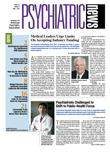New federal legislation aims to increase the number of pediatric mental health clinicians by cutting their “overwhelming educational debt” through loan repayments, grants, and scholarships.
The Child Health Care Crisis Relief Act (HR 1932), introduced by Rep. Patrick Kennedy (D-R.I.) on April 2, would ameliorate the shortage of psychiatrists and mental health professionals trained to treat children and adolescents by reducing financial barriers that may lead medical students to higher-paying areas of medicine.
“This bill will greatly alleviate the paucity of available specialists trained in child and adolescent psychiatry,” said Robert Hendren, D.O., president of the American Academy of Child and Adolescent Psychiatry (AACAP), in a written statement. “Enacting this legislation will allow child and adolescent psychiatrists to receive federal support to complete their training by removing a considerable financial burden.”
The legislation would authorize medical school loan repayment programs, scholarships, clinical training grants, and education grants for children's mental health professionals including child and adolescent psychiatrists, behavioral pediatricians, child psychologists, school psychologists, school social workers, school counselors, psychiatric nurses, and marriage and family therapists. The bill includes grants to graduate schools to help them launch and expand child and adolescent mental health education programs.
Child and adolescent psychiatry, Hendren noted, is the only medical specialty that provides comprehensive training to physicians to assess and treat children and adolescents' mental illnesses. However, efforts to increase the numbers of such specialists have been thwarted by “overwhelming educational debt” as well as pressure and incentives for medical students to pursue careers in primary care. Additional disincentives for students considering child and adolescent psychiatry include a long training period and insurance-reimbursement problems, according to a 2008 AACAP position paper.
The shortage of U.S. child and adolescent psychiatrists, according to AACAP, has reached a “crisis level,” with approximately 7,000 practicing in a country with about 73 million children and adolescents. On average only 300 specialists complete training each year. The number of child psychiatrists is insufficient to meet the demand for their care, when more than 13.7 million children and adolescents are in need of treatment for mental disorders, but only 20 percent of them receive adequate treatment, according to a 1999 U.S. surgeon general's report.
“Part of the reason for this alarming statistic is that mental health services specific to children are in very short supply,” Kennedy said.
Kennedy said his legislation stems from frustrated pediatricians repeatedly telling him that they cannot find available professionals for their patients who need mental health evaluations. Another factor that spurred the bill, Kennedy noted, was that large numbers of parents are unable to find or afford timely mental health care for their children. This predicament has led a growing number of parents to relinquish custody to the state, which is mandated to provide psychiatric care for its wards.
“This legislation seeks to increase the number of child mental health care professionals so that we can diagnose the problem early on and treat it,” said Rep. Ileana Ros-Lehtinen (R-Fla.), a cosponsor of the bill, in a written statement.
Kennedy said in a House floor speech that the bill is aimed not only at providing incentives for health care workers to choose mental health careers, but also at expanding treatment options for children.
The 2003 report of the President's New Freedom Commission on Mental Health found that most children and adolescents who receive treatment for psychiatric illnesses obtain it from their primary care physicians—who identify about 19 percent of their young patients as having a mental disorder. However, children with serious and persistent mental illness who do not improve with initial intervention from a primary care clinician may require the specialized treatment of a child and adolescent psychiatrist, according to AACAP.
The commission also found that children and adolescents who need mental illness treatment and do not receive it are at a higher risk for school failure, problems at home, substance abuse, and entrance into the juvenile-justice system.
The Child Health Care Crisis Relief Act can be accessed at<http://thomas.loc.gov> by searching on the bill number, HR 1932. ▪
